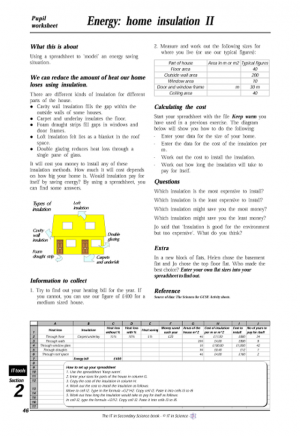Tools/Spreadsheets: Difference between revisions
mNo edit summary |
mNo edit summary |
||
| (4 intermediate revisions by 3 users not shown) | |||
| Line 1: | Line 1: | ||
{{ToolInfo | {{ToolInfo | ||
|title= | |title=Numbers, graphs and maths | ||
|tagline=Numbers, graphs and maths | |tagline=Numbers, graphs and maths - spreadsheet | ||
|image=Itinsecondaryscience5.png | |image=Itinsecondaryscience5.png | ||
| | |topic=spreadsheets, data handling, graphing, calculation | ||
|description= | |||
|ideas= | |ideas= | ||
|specs= | |specs= | ||
| Line 15: | Line 12: | ||
[[Category: | [[Category:Spreadsheet]] | ||
Latest revision as of 12:41, 23 October 2012
Tool Description A spreadsheet(tool) may have found itself in school by accident, but in no time at all, its calculating(tool) and graph(tool) drawing abilities found it a secure place. In science teaching, a spreadsheet is a ready-made results-table that quickly produces a graph. Graphs are a key tool for analysing data and a spreadsheet makes them with ease. In fact, spreadsheets can produce an astounding range of graphs. Our role as science teachers may be to encourage pupils to communicate effectively using graphs.
The ability of spreadsheets to organise, record and analyse data fulfils aspects of exploring science. If you had a table of students’ personal data, you could sort it into order of shoe size, or work out the average size of the class. You could draw a bar chart to see how the shoe sizes vary across the class. Or draw a scattergraph to see if the sizes vary with height. You might also search for those with black hair and see if they have an eye colour in common. Students can similarly use a spreadsheet to sort and search for patterns in the properties of elements in the periodic table
It may be clear already that students using a spreadsheet in these ways have to work scientifically. They would need to define what they want to find out, collect data, organise it and analyse it. A case can be put that the use of a spreadsheet belongs, and probably deserves a place in science teaching. (edit)
Teaching Approach. Spreadsheets can be used to engage pupils in the scientific method(ta) and mathematical thinking(ta), both as a tool to record results, and - through the use of functions and graphing techniques - a higher order(ta) reasoning(ta) device to problem solve and explore the best visualisation(ta) and analysis techniques. Some online tools (including Google Drive) support many of the functions of desktop spreadsheet applications such as Excel, and can thus be used for collaborative(ta) document editing. (edit)
| Tool details | |
| Title | Numbers, graphs and maths |
| Topic | [[Topics/Spreadsheets|Spreadsheets]], [[Topics/Data handling|Data handling]], [[Topics/Graphing|Graphing]], [[Topics/Calculation|Calculation]] |
| Licence / Cost / Platform | |
| Subject / Categories | ToolInfo, Spreadsheet, Spreadsheets, Data handling, Graphing, Calculation |
| Teaching Ideas / Links | |
| Link | |

